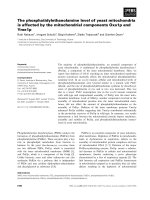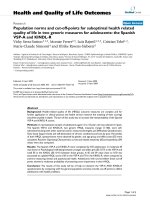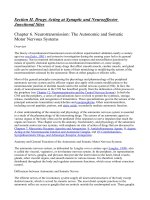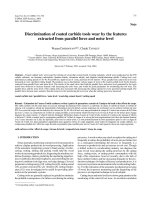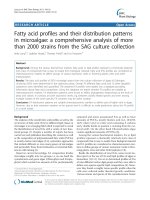PRACTICE TEST SECTION II: LEXICO AND GRAMMAR (60 POINTS)
Bạn đang xem bản rút gọn của tài liệu. Xem và tải ngay bản đầy đủ của tài liệu tại đây (98.99 KB, 11 trang )
PRACTICE TEST
SECTION II: LEXICO AND GRAMMAR (60 POINTS)
Part 1: Choose the word or phrase that best completes each sentence. Write your answer
(A,B,C, or D) in the numbered box.
1. General Custer was confident of victory despite being vastly...............by the enemy.
A. Outnumbered
B. outclassed
C. overcome
D. overtaken
2. The weather forecast predicted …………weather with snow, sunshine, wind, and thunder,
and that is what we have had
A. various
B. differing
C. variable
D. fluctuating
3. The ministry refused to .................the figures to the press.
A. release
B. leak
C. show
D. add
4. Steve...........his chances of passing by spending too much time on the first question.
A. threw out
B. threw off
C. threw away
D. threw in
5. The murderer has been put ……………..for 30 years
A. out
B. away
C. down
D. up
6. Since he spoke about the subject so indirectly, it was difficult to see what he was.........
A. getting at
B. getting on
C. getting in
D. getting up
7. James had,........., saved the manuscript of his first novel from the burning house
A. lastly
B. At last
C. lately
D.at least
8. Mr Nixon refused to answer the question on the.................that the matter was confidential.
A. reasons
B. excuses
C. grounds
D. foundation
9. The lawyer insisted that his client...........never have been arrested in the first place.
A. should
B. must
C. ought
D. would
10. As they came under heavy fire, the captain ordered his men to................
A. fall away
B. fall back
C. fall over
D. fall out
11. How votes will react to this latest political scandal.......to be seen.
A. is
B. remains
C. has
D. waits
12. “There is no further treatment we can give” said Dr JekyII.”. We must let the disease take
its.........
A. course
B. end
C. term
D. way
13. He walked from the court a free man, having been............of murder.
A. unconvinced
B. discharged
C. liberated
D. acquitted
14. Michael was the..........force behind the company’s rapid expansion.
A. managing
B. leading
C. rising
D. driving
15. I don’t think that this fashion will……………………….
A. catch up
B. catch out
C. catch on
D. catch over
16. As soon as you buy a car, it starts falling in..................
A. cost
B. worth
C. value
D. price
17. There's no point in telephoning him. He's certain ..................... by now.
A. to leave
B. to have left
C. left
D. having left
18. Giving up smoking is just one of the ways to ..................... heart disease.
A. push off
B. put off
C. ward off
D. throw off
19. The windows don't fit very well and this makes the room awfully.....................
A. airy
B. draughty
C. breezy
D. ventilated
20. I was proud to be....................... out for special praise for my performance.
A. selected
B. singled
C. separated
D.
distinguished
Part 2: The passage below contains 10 mistakes. Find and correct them.
Steeplechasing early began (began early) in the eighteenth century as a sport among the foxhunting gentry. In those days, they raced through (across) the countryside to a place marked by
a distant church spire, or steeple. It is a reckless and dangerous sport. By 1830, it became a part
of formal racing, and is today an established winter sport. The courses, which (of which) there
are over 40 in England and nearly 30 in Ireland, have artificial barriers in place of the real
ditches, walls, streams and hedges. From October to March, hundreds of steeplechase jockeys,
professional and amateur, risk life and limbs (limb). Of all the races in the steeplechasing
calendar, the most popular is the Grand National, run (running) over a distance of ten kilometers
and forty high jumps. Everyone in the country takes an interest to (in) it and most people seems
(seem) to buy a sweepstake ticket, or put a pound or two on the horse they think will win. In
some years, where (when) the going is especially bad, as much (many) as three-quarters of the
horses will not finish the race.
Part 4: Complete the following sentences with suitable phrasal verbs that are given below
then put them in correct verb tenses. Each phrasal verb is use only one time.
talk out of
draw up
go in for
split up
face up to
make up for
1. A: Are you going to Mick’s party tonight?
stand in for
come in for
feel up to
come up with
pull out of
look up to
B: No, I don’t ...............feel up to................it. I’ve got a bit of a headache.
2. Alan is off work today so I’m...............standing in for..........him at the meeting.
3. Now that you’re father you have to...........face up to........your responsibilities.
4. The bus.........drew up............at the traffic lights.
5. I was going to resign from my job, but my boss........talked........me......out of.....it.
6. What Jay lacked in experience, he .............made up for........... in enthusiasm.
7. The finance minister.........came in for..........a lot of criticism after he raised interest rates by
2%, but he defended himself vigorously.
8. I don’t really...........go in for.........team sports, but I play a lot of tennis and I go running twice a
week.
9. Due to cuts in the defence budget, the army will.....be pulled out of........the occupied
territories.
10. Did you hear Samantha and Oliver...............split up..............They look so sad recently.
Part 4: Write the correct form of each bracketed word in the spaces below. (0) has been
done as an example.
In 1999, as part of the UK's (0) CELEBRATE ______celebration________ of the millennium, a
huge rotating wheel, (1) ABLE _______CAPABLE_______ of carrying groups of passengers to
a great (2) HIGH _______HEIGHT_______ was built in the center of London, a short (3)
DISTANT _______DISTANCE_______ from the River Thames and the Houses or Parliament.
The construction of The London Eye was originally carried out through a (4) SPONSOR
______SPONSORSHIP________ deal with the airline, British Airways although the wheel is
now owned and operated by The London Eye Company. A typical trip round the wheel, (5) LAST
______LASTING ________ thirty minutes, gives tourists (6) BREATH
_______BREATHTAKING_______ views of the surrounding city and its many well-known
landmarks, (7) INCLUDE _______INCLUDING_______ Buckingham Palace, the Palace of
Westminster and Trafalgar Square. In its eight years of (8) CONTINUE
_______CONTINUOUS_______ operation, The London Eye has become the most popular
(9) PAY _______PAID_______ tourist attraction in the UK and it is easy to see why. At only a
little over fifteen pounds for a ticket, it certainly offers (10) BEAT
_______UNBEATABLE_______ value for money.
SECTION III. READING (40 POINTS)
Part 1: Read the following passage and choose the best option (A, B, C or D) to complete
the blank.
A Night Out In Bristol
EXAMPLE
0 A wish B hope C fancy
D dream
If you're in Bristol on a weekday evening and (0)...............a lively, boozy night out without getting
too badly (1).................off you could do worse than to try Fandangos, the new nightclub complex
on Lower Guzzlemore Street. Before eleven o'clock, prices are quite (2)............ and you can get
a (3)...............of four drinks for around a tenner. If like me, you're a bit of a (4).............it could
even set you back less than that. But for the heavyweights, more often than (5)............, they run
some kind of drinking competition at some point in the evening. On the evening I visited they
were offering a free pint to anyone who could (6).............their first pint in one – guaranteed to
leave even the most hardened heavyweight with a (7).............the next day. On most nights, the
dress (8)...............is fairly relaxed although they do seem to draw the line at torn jeans.
If, on the other hand, you're looking to (9)..............away from it all and enjoy a quiet beer or two
in somewhere a little more off the (10)..............track, The Pickwick Brewery Tap on Regents
Muse might be more to your liking. Despite the rather unoriginal name, this charming little pub is
not the fake tourist trap that you might expect. Most nights the other customers are nearly all
locals and regulars but from time to time they do get busloads of pensioners taking over the
place for an hour or two in the late afternoon.
1. A stolen
B lifted
C taken
D ripped
2. A reasonable
B respectful
C realistic
D resistible
3. A hand
B round
C pack
D stack
4. A weak-drinker
B lightweight
C low consumer
D soft head
5. A not
B ever
C never
D sometimes
6. A stomach
B down
C draw
D drain
7. A sore-brain
B head-bang
C heavy-head
D hangover
8. A plan
B rule
C code
D restriction
9. A run
B get
C go
D put
10. A well-known
B tourist
C beaten
D popular
Part 2: For questions 1-15, read the article below and think of the word which best fits
each gap. Use only one word in each gap. There is an example at the beginning.
THE TOUGHEST RUNNERS
There are a few runners who have completed every London Marathon since the first race in
1981. They are the toughest runners of (1)…………all……………These athletes, (2)………
in………honor of both their mental and physical strength, have been given a permanent entry in
the event for the rest of their lives, provided that they do not miss a year. Other people have (3)
……run……….the race faster or under greater handicaps, (4)……but…..these are athletes with
a mission. For them, the annual event is a way of life, not just a worthy fund-raising exercise (5)
…………or………a single challenge. Bill O’Connor is one of these runners. In his case, running
is a daily ritual which (6)……began…… in New Zealand, (7)…………where………… as a
youngster, he pounded along the wet sand on the edge of the Tasman Sea. Now aged fifty, (8)
………and……….working as a mathematics teacher at a school in London, he retains his
fascination (9)………with/for………..the London Marathon and the activity of running. He says,
“When the first London Marathon was held, I thought (10)…………to………….myself that here
was a challenge. I thought that if there was only going to be one race, I wanted to have run in
(11)………it…………” But the London Marathon went (12)…………on………..to become the
most impressive success story in British sport and Bill O’Connor has been a constant part of it.
(13)……Had……..he ever felt that he would fail to finish? “In 1985. It was a beautiful day and I
started running much (14)…………too………….fast for the first mile and got worried. So I slow
down for the next mile. Yet (15)……although….I expected I would take at least four hours, I
finished in two hours thirty-four minutes and twenty-nine seconds”. It is his best time so far.
Part 3: Read the passage below, then choose the correct answer by circling (A, B, C or D).
Archaeological records ― paintings, drawings, and carvings of humans engaged in
activities involving the use of hands ― indicate that humans have been predominantly righthanded for more than 5,000 years. In ancient Egyptian artwork, for example, the right-hand is
depicted as the dominant one in about 90percent of the examples. Fracture or wear patterns on
tools also indicate that a majority of ancient people were right-handed.
Cro-Magnon cave paintings some 27,000years old commonly show outlines of human hands
made by placing one hand against the cave wall and applying paint with the other. Children
today make similar outlines of their hands with crayons on paper. With few exceptions, left hands
of Cro-Magnons are displayed on cave walls, indicating that the paintings were usually done by
right-handers.
Anthropological evidence pushes the record of handedness in early human ancestors back to
at least 1.4 million years ago. One important line of evidence comes from flaking patterns of
stone cores used in tool making: implements flaked with a clockwise motion (indicating a righthanded toolmaker) can be distinguished from those flaked with a counter-clockwise rotation
(indicating a left-handed toolmaker).
Even scratches found on fossil human teeth offer clues. Ancient humans are thought to have
cut meat into strips by holding it between their teeth and slicing it with stone knives, as do the
present-day Inuit. Occasionally the knives slip and leave scratches on the users` teeth.
Scratches made with a left-to-right stroke direction (by right-handers) are more common than
scratches in the opposite direction (made by left-handers).
Still other evidence comes from cranial morphology: scientists think that physical differences
between the right and left sides of the interior of the skull indicate subtle physical differences
between the two sides of the brain. The variation between the hemispheres corresponds to
which side of the body is used to perform specific activities. Such studies, as well as studies of
tool use, indicate that right- or left-sided dominance is not exclusive to modern Homo sapiens.
Populations of Neanderthals, such as Homo erectus and Homo habilis, seem to have been
predominantly right-handed, as we are.
1. What is the main idea of the passage?
(A) Human ancestors became predominantly right-handed when they began to use tools.
(B) It is difficult to interpret the significance of anthropological evidence concerning tool use.
(C) Humans and their ancestors have been predominantly right-handed for over a million years.
(D) Human ancestors were more skilled at using both hands than modern humans.
2. The word "other" refers to
(A) outline
B) hand
(C) wall
(D) paint
3. What does the author say about Cro-Magnon paintings of hands?
(A) Some are not very old.
(B) It is unusual to see such paintings.
(C) Many were made by children.
(D) The artists were mostly right-handed.
4. The word "implements" is closest in meaning to
(A) tools
(B) designs
(C) examples
(D) pieces
5. When compared with implements "flaked with a counter-clockwise rotation"), it can be
inferred that "implements flaked with a clockwise motion" are
(A) more common
(B) larger
(C) more sophisticated
(D) older
(C) damage
(D) information
6. The word "clues" is closest in meaning to
(A) solutions
(B) details
7. The fact that the Inuit cut meat by holding it between their teeth is significant because
(A) the relationship between handedness and scratches on fossil human teeth can be verified
(B) it emphasizes the differences between contemporary humans and their ancestors
(C) the scratch patterns produced by stone knives vary significantly from patterns produced by
modern knives
(D) it demonstrates that ancient humans were not skilled at using tools
8. The word "hemispheres" in line 24 is closest in meaning to
(A) differences
(B) sides
(C) activities
(D) studies
9. Why does the author mention Homo erectus and Habilis
(A) To contrast them with modern humans
(B) To explain when human ancestors began to make tools
(C) To show that early humans were also predominantly right-handed
(D) To prove that the population of Neanderthals was very large
10. All of the following are mentioned as types of evidence concerning handedness
EXCEPT
(A) ancient artwork
(B) asymmetrical skulls
(C) Studies of tool use
(D) fossilized hand bones
Part 4: Read the following passage and do the tasks that follow
A. Match the headings given below with their appropriate numbers that lead the six
paragraphs and write the letters I- X in corresponding numbered boxes (the headings
outnumber the paragraphs, so you will not use all of them)
I. Process of formation
II. Effect of a storm surge
III. Defining characteristics
IV. Systems for identifying
V. Damage effects
VI. History of hurricanes
VII. System for classification
VIII. Speculation about cause
IX. Effect of low pressure
X. The Carib god of Evil
A..................................
A hurricane is a tropical cyclone, an area of intense low pressure in the tropics surrounded by a
violent rotating storm. It is called a hurricane in the North Atlantic, the Northeast Pacific east of
the dateline, and the South Pacific Ocean east of 160E; west of the dateline it is called a
typhoon, and in the Indian ocean, a cyclone. It becomes a hurricane officially if its wind speeds
reach 74mph, or force 12 on the Beaufort scale; below that it is a tropical storm. Every year,
there are about 100 tropical storms and about 50 of them reach hurricane strength. The name
comes from "Hurricane", the Carib god of evil.
B.....................................
Hurricanes need precise meteorological conditions to form: the sea surface temperature needs
to be above 26.5C.
They are formed over the tropical ocean when strong clusters of
thunderstorms drift over warm water. Warm air from the storm and the ocean surface combine
and begin to rising, creating an area of low pressure on the ocean surface. Rising warm air
causes pressure to decrease at higher altitudes. Air rises faster and faster to fill the low
pressure, in turn drawing more warm air up off the sea and sucking cold air downwards. The
cluster of thunderstorms merge to become a huge storm, which moves west with the trade
winds. While it remains over warm water, the tropical wave begin to grow. Wind speeds increase
as air is sucked into the low pressure centre. If the depression strengthens and its win speed
climbs above 10mph it become a tropical storm and is named by US National Hurricane Centre
Once. If the sustained wind exceed 74 mph, the storm become a hurricane. It can take as long
as several days or only a few hours for a depression to develop into a full – blown hurricane. The
fully developed hurricane is made up of an eye of calm winds surrounded by a spinning vortex of
high winds and heavy rainstorms. Around the eye winds grow with great velocity, generating
violent seas.
C......................................
Hurricanes produce the highest wind speeds, up to 200mph in the most extreme cases, which
only the strongest structures can withstand. They produce absolutely enormous amounts of rain
which can lead to catastrophic flash floods. But sometimes most seriously - they produce a
phenomenon known as a storm surge. This is a huge raising of the sea level, caused jointly by
the huge winds and the very low atmospheric pressure. In the most extreme cases it can be as
much as 25ft above normal.
The hurricane pushes this heightened sea along in front of its path and when it hits the coastline,
especially the low-lying coasts, there can be disastrous inundations, especially when the surge
combines with torrential rain. Britain experienced something like this on 30 January 1953 when a
violent gale combined with very low pressure produced a storm surge in the North Sea, which
breached the sea defences of Lincolnshire and East Anglia and drowned 307 people. Once a
hurricane reaches land, it tends to die out fairly quickly as there is no more warm water to supply
heat. But out in the open ocean it can last for a fortnight or more.
D.....................................................
Hurricanes are now measured between strengths 1 and 5 on the Saffir-Simpson scale,
formulated in 1969 by Herbert Saffir, a consulting engineer, and Dr Bob Simpson, the director of
the US National Hurricane Centre. The scale was devised in the aftermath of Hurricane Camille
in 1969, the most violent storm ever to hit the continental United States. Its categories run like
this:
Category one (minimal): winds 75 to 95mph, minor flooding, slight structural damage, storm
surge up to 1.5 metres.
Category two (moderate): winds between 96 and 110mph, roof and tree damage, storm surge
1.8 to 2.4m.
Category three (extensive): winds between 111 and 130mph, houses damaged, severe
flooding, storm surge 2.7 to 3.7m
Category four (extreme): winds of between 131 and 155mph, major structural damage to
houses and some roofs destroyed, storm surge of between 4 and 5.5m.
Category five (catastrophic): winds above 155mph, many buildings destroyed, smaller ones
blown away completely, severe inland flooding, storm surge of more than 5.5m.
E..........................................
Although global warming is confidently expected to produce more violent storms, scientists
cannot yet prove a link between current hurricane rates and climate change. There does not
seem to have been an increase in the number of category five hurricanes world-wide. This year
appears to be more active than 2003 and 2002 but less active than the four years before that.
F..........................................
All tropical cyclones are named, to provide ease of communication between forecasters and the
general public about forecasts, watches, and warnings. Since the storms can often be longlasting and more than one can be occurring in the same region at the same time, names can
reduce the confusion about which storm is being described. Before the 20th century, especially
in the Caribbean, hurricanes were sometimes named after the saint's day on which they struck
land. During the Second World War, US Navy meteorologists gave them the female names of
wives and loved ones, but by 1950 a formal naming strategy was in place for North Atlantic
cyclones, based on the phonetic alphabet of the time (Able, Baker, Charlie and so on.). In 1953
the US Weather Bureau decided to switch to female first names, and with the agreement of the
World Meteorological Association, included male first names in the list in 1979. Each
meteorological region of the world now has an agreed list of names. The letters Q, U, X, Y, and Z
are not used because few names begin with these letters. Quite a few hurricane names including Andrew, Betsy, Bob, Camille, Hugo and Hilda - have been officially retired because the
storms concerned caused damage on a scale unlikely to be repeated. About 50 names have
been retired: a country can request retirement.
Your answers
1. Section A:
2. Section B:
3. Section C:
4. Section D:
5. Section E:
6. Section F:
B. The following sentences can be true (T), false (F) or not given (NG) according to the
passage. Read the passage carefully, then write your answers.
1. Warm waters are the sole reason to fuel the heat engine of the tropical cyclone.
2. Hurricanes is a tropical cyclone in which the maximum sustained surface wind is 74 mph or
more.
3. Hurricanes can form a storm surge when the wind speed up to highest level.
4. The centers of hurricanes are warmer than their surroundings
SECTION IV: WRITING (40 POINTS)
Part 1: Use the word(s) given in brackets and make any necessary additions to complete
a new sentence in such a way that it is as similar as possible in meaning to the original
sentence. Do not change the form of the given word(s).
1. I like to take my time to decide, not rush important things. (SNAP)
=> I don't like to make snap decisions on important things.
2. I know it is unlikely, but if you see Mum, could you give her this money.( HAPPEN)
=> If you should happen to see Mum, could you give her this money.
3. Generally speaking, this has been a successful year for this company. (LARGE)
=> This has by large been a successful year for this company.
4. If children were allowed to do what they wanted, they would probably watch TV all day (OWN)
=> If children were left to their own devices, they would probably watch TV all day.
5. It’s what people eat that betrays their social background, not their table manners.(GIVE)
=> What gives people's social background away is what they eat , not their table manner.
Part 2: Complete the second sentence so that it has a similar meaning to the first
sentence.
1. The boy wasn't allowed to have any friends, so he became an introvert.
=> Deprived of friends, he became an introvert.
2. What a pity these shops close at lunch-time.
=> I wish these shops didn't close at lunch-time.
3. I wasn't surprised when they refused to pay me.
=> As I had expected, they refused to pay me.
4. It probably takes at least six hours to drive to Glasgow from here.
=> It’s probably at least a 6-hour drive to Glasgow from here
5. It was such an appalling sight that we reeled back in horror.
=> So appalling was the sight that we reeled back in horror.


